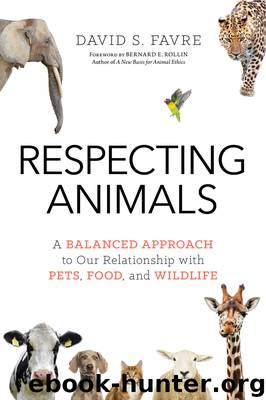Respecting Animals by David S. Favre

Author:David S. Favre
Language: eng
Format: epub
ISBN: 9781633884267
Publisher: Prometheus Books
MAKING COLLECTIVE JUDGMENTS
In 2008, an undercover video taken by the Humane Society of the United States was released showing the pushing of a downed cow by a bulldozer at a slaughterhouse. Anyone who sees this footage most likely will make an immediate, holistic judgment that the human treatment of the animal in this film is ethically wrong, whether or not it was illegal.2 It does not matter that in thirty minutes the animal will be killed to provide food for humans; in fact, in some ways that makes the issue even more important. (The video and resulting public reaction provide the political impulse for changing the law to make it clear that such conduct is unacceptable in our society.) This is an example of individual ethical decisions coming together with one vision or voice and creating a group ethical decision. There is no need for a scientific expert to discuss the matter, and no defense could possibly be offered up by the actors. It is also an example of what most individuals would categorize as disrespectful—if not downright cruel—actions by a human to an animal. Some decisions do not need a logical analysis.
The pictures of the clubbing of baby seals on the Canadian ice flows bring the same sort of revulsion to most viewers: it is unacceptable conduct. The death of the young, the spattering of blood, the mother seals in anguish, give all the clues necessary to trigger a negative holistic judgment in the viewer. (For a sample of this visceral public impact, type “seal clubbing” into YouTube's search bar.) Being offered the additional information that the person needs the seal pelts to make money and that death by crushing the brain is sometimes near instantaneous for the seal pup does not sway us from this judgment. The human interests do not seem to overcome the overwhelming visual impact of what is happening to specific individual baby seals.
Yes, emotion is part of the judgment, but whether we acknowledge it or not, emotions have always been part of the judgment-making process. Sometimes emotions will lead us places that on balance we should not go, and in such instances the logic center acts as counterpoint to the holistic, quick response. Road rage is an example of emotion resulting in a bad outcome. But the logic center may not be able to take charge until after the heat of the moment. (That is one reason we have so many humans in jail. When asked about why a convicted person acted as they did, a common response is: “It seemed like a good idea at the time. What was I thinking?”)
One of the keys to the above examples is how important the visual impression is to the making of holistic decisions. Pictures speak more than a thousand words. Of course pictures are also a possible starting point for logical discussion, consideration, and judgment. But when seeing a scene for the first time, it is hard not to react with a quick judgment, which may or may not be followed up with a contemplative reflection of what is truly within the picture.
Download
This site does not store any files on its server. We only index and link to content provided by other sites. Please contact the content providers to delete copyright contents if any and email us, we'll remove relevant links or contents immediately.
Second Nature (The Shape-Shifter Series #1) by Jae(1051)
Petroleum Contracts by Peter Roberts(866)
The Global Commons by Susan J. Buck(863)
Infrastructure by Frischmann Brett M(810)
The Monk by Matthew Lewis(790)
Japan Travel Guide: Things I Wish I Knew Before Going To Japan (2019 EDITION) by Fukuyama Ken & Fukuyama Yuki(773)
Ever After by William Wharton(743)
Before Earth Day by Karl Boyd Brooks(714)
Good for You, Great for Me by Lawrence Susskind(708)
War of the Whales by Joshua Horwitz(685)
Biting the Hands that Feed Us by Baylen J. Linnekin(676)
Respecting Animals by David S. Favre(654)
Uncommon Ground by William Cronon(652)
Animal Law in a Nutshell by Frasch Pamela & Hessler Katherine & Waisman Sonia(651)
After Nature: A Politics for the Anthropocene by Jedediah Purdy(641)
Rangeland Systems by David D. Briske(640)
The Ethics of Space Exploration by James S.J. Schwartz & Tony Milligan(632)
Fracking the Neighborhood by Jessica Smartt Gullion(607)
Down to the Wire: Confronting Climate Collapse by David W. Orr(598)
